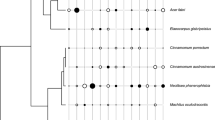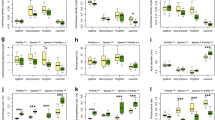Abstract
Aims
Plants with precise root foraging patterns can proliferate roots preferentially in nutrient-rich soil patches. When nutrients are distributed heterogeneously, this trait is often competitively advantageous in pot experiments but not field experiments. We hypothesized that this difference is due to belowground herbivory under field conditions.
Methods
We performed pot experiments using seedlings of Lolium perenne (a more precise root foraging species) and Plantago lanceolata (a less precise root foraging species). The experiment had a two-way factorial randomized block design, with nutrient distribution pattern (homogeneous or heterogeneous) and belowground herbivore (present or absent) as the two factors. Each pot contained one seedling of each species.
Results
With no herbivore present, plant biomass was smaller in the heterogeneous nutrient treatment than in the homogeneous treatment in P. lanceolata, but not in L. perenne. Under homogeneous nutrient distribution, plant biomass was lower in both species with a herbivore present than with no herbivore. Under heterogeneous nutrient distribution, biomass reduction due to herbivory occurred only in L. perenne.
Conclusions
Roots of the precise root foraging species were grazed more under the heterogeneous nutrient distribution, suggesting that the herbivore more efficiently foraged for roots in nutrient-rich soil patches.



Similar content being viewed by others
References
Bliss KM, Jones RH, Mitchell RJ, Mou P (2002) Are competitive interactions influenced by spatial nutrient heterogeneity and root foraging behavior? New Phytol 154:409–417
Blossey B, Hunt-Joshi TR (2003) Belowground herbivory by insects: influence on plants and aboveground herbivores. Ann Rev Entomol 48:521–547
Brown VK, Gange AC (1990) Insect herbivory below ground. Adv Ecol Res 20:1–58
Cain ML, Subler S, Evans JP, Fortin MJ (1999) Sampling spatial and temporal variation in soil nitrogen availability. Oecologia 118:397–404
Coverdale TC, Altieri AH, Bertness MD (2012) Belowground herbivory increases vulnerability of New England salt marshes to die-off. Ecology 93:2085–2094
Crutchfield BA, Potter DA (1994) Preferences of Japanese beetle and southern masked chafer (Coleoptera: Scarabaeidae) grubs among cool-season turfgrasses. J Entomol Sci 29:398–406
de Kroon H, Hendriks M, van Ruijven J, Ravenek J, Padilla FM, Jongejans E, Visser EJW, Mommer L (2012) Root responses to nutrients and soil biota: drivers of species coexistence and ecosystem productivity. J Ecol 100:6–15
Drew MC (1975) Comparison of the effects of a localized supply of phosphate, nitrate, ammonium and potassium on the growth of the seminal root system, and the shoot, in barley. New Phytol 75:479–490
Einsmann JC, Jones RH, Pu M, Mitchell RJ (1999) Nutrient foraging traits in 10 co-occurring plant species of contrasting life forms. J Ecol 87:609–619
Farley RA, Fitter AH (1999) Temporal and spatial variation in soil resources in a deciduous woodland. J Ecol 87:688–696
Gerber E, Hinz HL, Blossey B (2007) Impact of the belowground herbivore and potential biological control agent, Ceutorhynchus scrobicollis, on Alliaria periolata performance. Biol Control 42:355–364
Grime JP, Hodgson JG, Hunt R (1988) Comparative plant ecology: a functional approach to common British species. Unwin Hyman, London
Hodge A (2003) Plant nitrogen capture from organic matter as affected by spatial dispersion, interspecific competition and mycorrhizal colonization. New Phytol 157:303–314
Hodge A (2004) The plastic plant: root responses to heterogeneous supplies of nutrients. New Phytol 162:9–24
Hodge A, Robinson D, Griffiths BS, Fitter AH (1999) Why plants bother: root proliferation results in increased nitrogen capture from an organic patch when two grasses compete. Plant Cell Environ 22:811–820
Hutchings MJ, de Kroon H (1994) Foraging in plants: the role of morphological plasticity in resource acquisition. Adv Ecol Res 25:159–238
Hutchings MJ, John EA, Wijesinghe DK (2003) Toward understanding the consequences of soil heterogeneity for plant populations and communities. Ecology 84:2322–2334
Jackson RB, Caldwell MM (1993) Geostatistical patterns of soil heterogeneity around individual perennial plants. J Ecol 81:683–692
Jackson RB, Mooney HA, Schulze E-D (1997) A global budget for fine root biomass, surface area, and nutrient contents. Proc Natl Acad Sci U S A 94:7362–7366
James SE, Pärtel M, Wilson SD, Peltzer DA (2003) Temporal heterogeneity of soil moisture in grassland and forest. J Ecol 91:234–239
Johnson SN, Murray PJ (2008) Root feeders: an ecosystem perspective. CABI, Wallingford
Joshi J, Matthies D, Schmid B (2000) Root hemiparasites and plant diversity in experimental grassland communities. J Ecol 88:634–644
Kachi N (1983) Population dynamics and life history strategy of Oenothera erythrosepala in a sand dune system. Ph. D. Thesis, The University of Tokyo
Kachi N, Hirose T (1985) Population dynamics of Oenothera glazioviana in a sand dune system with special reference to the adaptive significance of size-dependent reproduction. J Ecol 73:887–901
Lundholm JT, Larson DW (2003) Temporal variability in water supply controls seedling diversity in limestone pavement microcosms. J Ecol 91:966–975
Maestre FT, Bradford MA, Reynolds JF (2005) Soil nutrient heterogeneity interacts with elevated CO2 and nutrient availability to determine species and assemblage responses in a model grassland community. New Phytol 168:637–650
Nakamura R, Kachi N, Suzuki J-I (2008) Root growth and plant biomass in Lolium perenne exploring a nutrient-rich patch in soil. J Plant Res 121:547–557
Potter DA, Held DW (2002) Biology and management of the Japanese beetle. Annu Rev Entomol 47:175–205
R Development Core Team (2012) R: a language and environment for statistical computing. R Foundation for Statistical Computing, Vienna, http://www.R-project.org/
Rajaniemi TK, Reynolds HL (2004) Root foraging for patchy resources in eight herbaceous plant species. Oecologia 141:519–525
Robinson D, Rorison IH (1983) A comparison of the responses of Lolium perenne L., Holcus lanatus L. and Deschampsia flexuosa (L.) Trin. to a localized supply of nitrogen. New Phytol 94:263–273
Robinson D, Hodge A, Griffiths BS, Fitter AH (1999) Plant root proliferation in nitrogen-rich patches confers competitive advantage. Proc Roy Soc Lond Ser B Biol Sci 266:431–435
Sakai K, Fujioka M (2007) Atlas of Japanese Scarabaeoidea. Vol. 2. Phytophagous group I. Roppon-Ashi Entomological Books, Tokyo (in Japanese)
Stevens GN, Jones RH (2006a) Influence of root herbivory on plant communities in heterogeneous nutrient environments. New Phytol 171:127–136
Stevens GN, Jones RH (2006b) Patterns in soil fertility and root herbivory interact to influence fine-root dynamics. Ecology 87:616–624
Stevens GN, Spence KO, Lewis EE (2008) Root feeders in heterogeneous systems: foraging responses and tropic interactions. In: Johnson SN, Murray PG (eds) Root feeders: an ecosystem perspective. CABI, Wallingford, pp 171–191
Strong DR, Maron JL, Connors PG, Whipple A, Harrison S, Jefferies RL (1995) High mortality, fluctuation in numbers, and heavy subterranean insect herbivory in bush lupine, Lupinus arboreus. Oecologia 104:85–92
Sun Y, Gu J, Zhuang H, Guo D, Wang Z (2011) Lower order roots more palatable to herbivores: a case study with two temperate tree species. Plant Soil 347:351–361
Townsend CR, Begon M, Harper JL (2003) Essentials of ecology, 2nd edn. Blackwell Science, Malden
Tsunoda T, Kachi N, Suzuki J-I (2014) Effects of belowground vertical distribution of a herbivore on plant biomass and survival in Lolium perenne. Ecol Res 29:351–355
Wijesinghe DK, John EA, Beurskens S, Hutchings MJ (2001) Root system size and precision in nutrient foraging: responses to spatial pattern of nutrient supply in six herbaceous species. J Ecol 89:972–983
Acknowledgments
We thank E. Sugiyama and T. Yasuki of Tokyo Metropolitan University for their help in the experiment. Prof. A. Nishiwaki made constructive comments on an earlier version of our manuscript. We are grateful to the two anonymous reviewers and the editors for their constructive comments on our manuscript.
Author information
Authors and Affiliations
Corresponding author
Additional information
Responsible Editor: Jeffrey Walck.
Electronic supplementary material
Below is the link to the electronic supplementary material.
Supplemental Table 1
(XLSX 42 kb)
Rights and permissions
About this article
Cite this article
Tsunoda, T., Kachi, N. & Suzuki, JI. Interactive effects of soil nutrient heterogeneity and belowground herbivory on the growth of plants with different root foraging traits. Plant Soil 384, 327–334 (2014). https://doi.org/10.1007/s11104-014-2215-5
Received:
Accepted:
Published:
Issue Date:
DOI: https://doi.org/10.1007/s11104-014-2215-5




